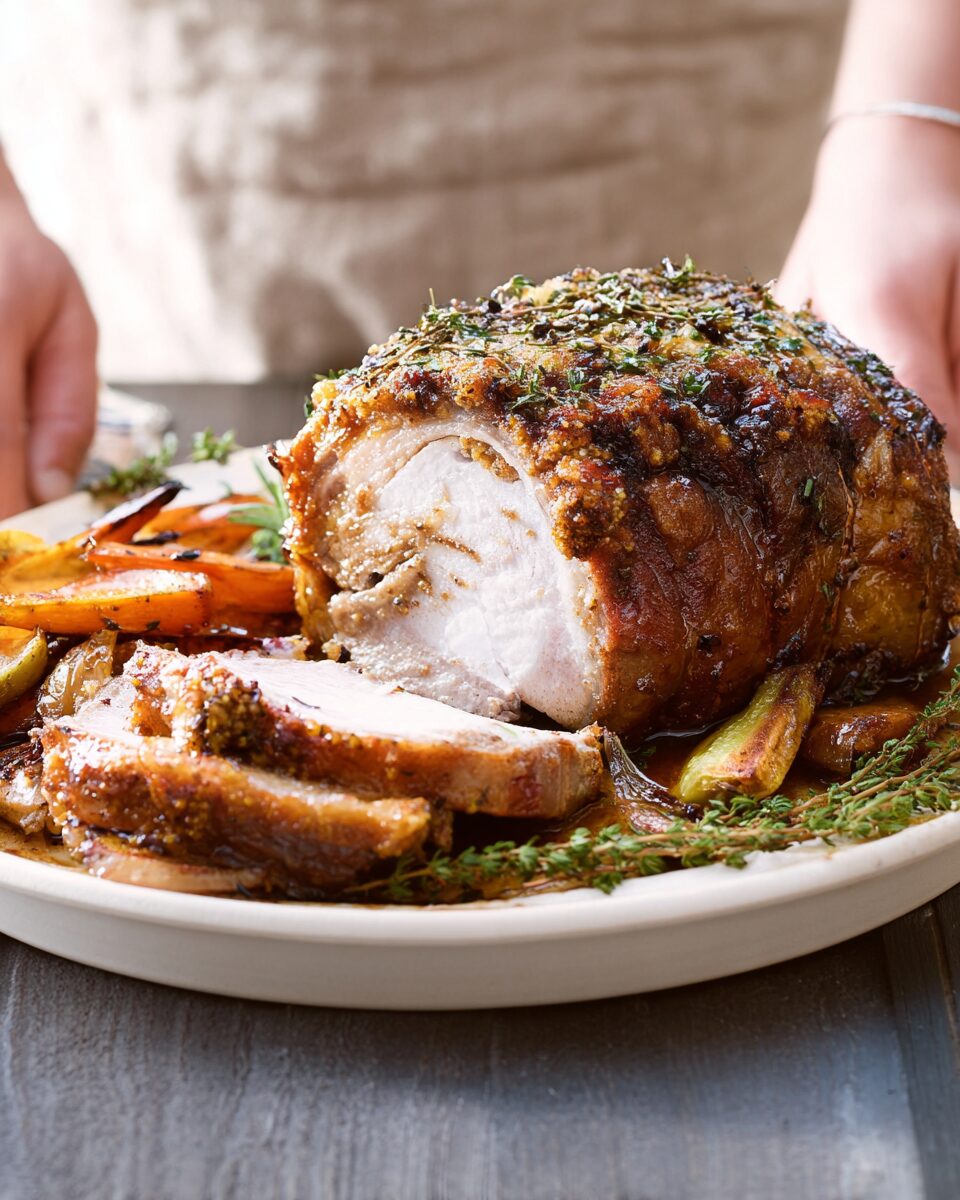This Slow-Roasted Pork with Thyme and Marjoram is a showstopper dish that combines the savory depth of herbs with melt-in-your-mouth tenderness. The slow cooking process makes the pork shoulder juicy and flavorful, with a perfectly crispy skin that everyone will rave about. The rich aroma of thyme and marjoram fills the air, making this a comforting and hearty meal perfect for any occasion.
The garlic and onions add another layer of flavor, while the white wine and chicken stock help create a rich and aromatic sauce that complements the pork beautifully. Serve this dish with your favorite roasted vegetables, mashed potatoes, or a simple green salad for a complete meal that will leave everyone satisfied and asking for seconds.
Full Recipe:
-
2 kg boneless pork shoulder, skin scored
-
1 tablespoon olive oil
-
1 tablespoon sea salt
-
2 teaspoons cracked black pepper
-
2 tablespoons fresh thyme leaves
-
2 tablespoons fresh marjoram leaves
-
6 cloves garlic, smashed
-
2 onions, quartered
-
1 cup dry white wine
-
1 cup chicken stock
Directions:
-
Preheat the oven to 160°C (320°F).
-
Rub the pork shoulder with olive oil, sea salt, black pepper, thyme, marjoram, and smashed garlic.
-
Place the onions in the bottom of a large roasting pan and sit the pork on top, skin-side up.
-
Pour the white wine and chicken stock around the pork.
-
Cover the pan tightly with aluminum foil and roast for 3 hours, or until the pork is very tender.
-
Remove the foil and roast for an additional 30 minutes to crisp the skin.
-
Let the pork rest for 10-15 minutes before slicing.
Prep Time: 15 minutes | Cooking Time: 3 hours 30 minutes | Total Time: 3 hours 45 minutes
Kcal: 430 kcal | Servings: 6 servings
History and Origin
Pork, being one of the most commonly consumed meats around the world, has long been a centerpiece of many culinary traditions. Slow-roasting pork is a method that has been used for centuries, particularly in Europe, where it was a popular way of preparing meats for long, leisurely meals. The process of slow roasting was originally used as a means to tenderize tougher cuts of meat, and it has since become a beloved method of cooking due to the deep, rich flavors it imparts.
Thyme and marjoram are two herbs with ancient roots in European cuisine. Thyme has been used since ancient Greece and Rome, prized for its medicinal qualities and robust flavor. Marjoram, a close relative to oregano, was also a favored herb in Mediterranean cooking, known for its slightly sweet and floral notes. Together, these herbs form a flavor profile that perfectly complements the richness of pork.
In terms of cultural significance, roasted pork dishes are a staple in many holiday and festive meals worldwide. In Italy, for example, slow-roasted pork is often a centerpiece for Christmas dinner, while in the United States, a slow-roasted pork shoulder might be the star of a family BBQ. The combination of thyme and marjoram in this dish adds a Mediterranean touch, making it a cross-cultural favorite.
Variations and Adaptations
While the basic recipe for slow-roasted pork with thyme and marjoram is simple and straightforward, there are several variations depending on the region or personal taste preferences.
-
Spices and Herb Variations: While thyme and marjoram are the featured herbs in this recipe, many home cooks enjoy experimenting with other fresh herbs like rosemary, sage, or bay leaves. In certain regional variations, a touch of garlic or lemon zest is added to brighten the flavor profile. For a more robust seasoning, some recipes include smoked paprika, cumin, or chili flakes for a smoky, slightly spicy kick.
-
Cooking Method Variations: Traditionally, the pork is roasted slowly in the oven, but for those who enjoy outdoor cooking, slow-roasting over a grill or in a smoker can infuse the meat with a wonderful smoky flavor. Some people also braise the pork, cooking it in liquid (like wine or broth) until it becomes so tender that it shreds easily. This method can add an extra layer of depth to the dish.
-
Serving Variations: In some cultures, roasted pork is served with traditional sides like mashed potatoes, roasted vegetables, or a hearty cabbage dish. In other places, like in the American South, the pork might be paired with cornbread or collard greens. In more Mediterranean-inspired variations, roasted vegetables such as tomatoes, potatoes, and carrots may be cooked alongside the pork, absorbing its savory juices.
-
Vegetarian Adaptation: While this dish is inherently non-vegetarian, a vegetarian-friendly adaptation could involve slow-roasting a hearty vegetable such as cauliflower or a large mushroom like portobello, seasoned with thyme and marjoram, to mimic the texture and flavors of the roast.
Nutritional Information
Slow-roasted pork with thyme and marjoram is a satisfying meal that packs plenty of protein and healthy fats. Depending on the cut of pork you choose, the nutritional content will vary, but here’s an average breakdown for a typical serving:
-
Calories: A 4-ounce portion of roasted pork shoulder (without skin) contains around 290 calories, though this can vary based on the amount of fat retained in the meat.
-
Protein: Pork is an excellent source of high-quality protein, with each serving delivering roughly 25 grams of protein. This makes it a great option for those looking to maintain or build muscle.
-
Fat: Roasted pork can be relatively high in fat, especially if you’re using cuts like shoulder or belly. A serving typically contains 15-20 grams of fat, which includes both saturated and unsaturated fats. Choosing leaner cuts, like pork tenderloin, can reduce the fat content.
-
Carbohydrates: The pork itself contains virtually no carbs, making it a great choice for those following low-carb diets like keto or paleo. However, the serving sides and any added sauces can introduce some carbohydrates.
-
Vitamins and Minerals: Pork is a good source of B vitamins, particularly thiamine, niacin, and vitamin B6, which are essential for energy production and brain function. Additionally, pork provides a decent amount of selenium and zinc, which play vital roles in immune function.
Serving Suggestions and Pairings
This slow-roasted pork dish is hearty enough to be served as a main course for a large meal. Here are a few ideas for side dishes and beverages that pair beautifully with this flavorful roast:
-
Sides: A classic pairing with roasted pork is mashed potatoes or roasted sweet potatoes. The rich, creamy texture of the potatoes balances the savory flavors of the meat. Additionally, roasted vegetables like Brussels sprouts, carrots, and parsnips work well, especially when cooked in the same roasting pan to absorb the pork’s juices. A simple green salad with a tangy vinaigrette will add a refreshing contrast to the richness of the pork.
-
Beverages: For drinks, a dry white wine such as Chardonnay or Sauvignon Blanc complements the herbal notes of the thyme and marjoram. Alternatively, a light red wine like Pinot Noir or a chilled rosé would provide a refreshing and fruity contrast to the savory roast. If you prefer a non-alcoholic beverage, a chilled iced tea with lemon or sparkling water with a twist of citrus would be ideal.
Tips and Tricks for Success
-
Searing the Pork: For a crispy, golden skin on the pork, make sure to sear the skin under high heat before roasting. This will help it become crispy as it cooks.
-
Slow Cooking: While it might be tempting to increase the oven temperature for a quicker roast, resist the urge! Slow-roasting at a low temperature is key to achieving that tender, fall-apart texture. The longer cooking time allows the fat to melt slowly, resulting in juicier meat.
-
Resting Time: Let the pork rest after removing it from the oven to allow the juices to redistribute. This helps ensure the pork remains moist and tender when sliced.
-
Use a Meat Thermometer: To ensure the pork is cooked through without overcooking it, use a meat thermometer. The internal temperature should reach around 95°C (203°F) for the perfect tender roast.
Potential Health Benefits
The primary health benefits of slow-roasted pork come from its protein content and essential vitamins and minerals. Pork is an excellent source of complete protein, which is important for tissue repair, immune function, and muscle growth. The B vitamins found in pork help support metabolism and energy production, while minerals like zinc contribute to immune health and cell growth.
However, because pork can be high in saturated fat, it’s essential to enjoy it in moderation, especially for those watching their cholesterol or trying to maintain a healthy heart. Opting for leaner cuts like tenderloin or loin and trimming excess fat can help make the dish more heart-healthy.
Conclusion
Slow-roasted pork with thyme and marjoram is a delicious, comforting meal that brings rich flavors and tender meat to the table. Whether served during a special holiday or as a regular family dinner, it’s a dish that will surely impress. With its simple ingredients and straightforward preparation, this recipe is perfect for those looking to enjoy a traditional, wholesome meal with minimal fuss. So why not give it a try? You’ll be amazed by how easy it is to create a gourmet feast at home, and your family or guests will be asking for seconds!





